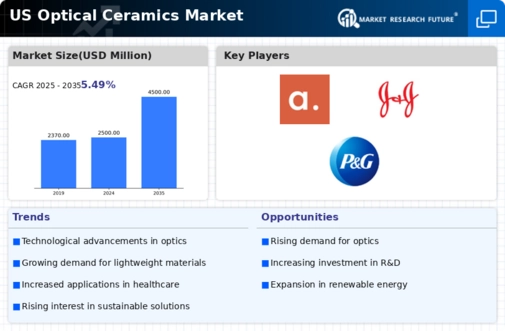The optical ceramics market is characterized by a dynamic competitive landscape, driven by technological advancements and increasing demand across various applications, including telecommunications, defense, and consumer electronics. Key players such as Corning Inc (US), Schott AG (DE), and II-VI Incorporated (US) are at the forefront, each adopting distinct strategies to enhance their market positioning. Corning Inc (US) focuses on innovation and product development, particularly in specialty glass and ceramics, while Schott AG (DE) emphasizes strategic partnerships to expand its product offerings and market reach. II-VI Incorporated (US) is actively pursuing mergers and acquisitions to bolster its capabilities in optical materials, thereby shaping a competitive environment that is increasingly collaborative yet fiercely competitive.
In terms of business tactics, companies are localizing manufacturing to reduce lead times and optimize supply chains, which is crucial in a market that is moderately fragmented. This localization strategy not only enhances operational efficiency but also allows companies to respond swiftly to regional demands. The collective influence of these key players contributes to a competitive structure that is characterized by both innovation and strategic alliances, fostering a robust ecosystem for optical ceramics.
In November 2025, Corning Inc (US) announced the launch of a new line of advanced optical ceramics designed for high-performance applications in telecommunications. This strategic move is significant as it positions Corning to capitalize on the growing demand for high-speed data transmission, thereby reinforcing its leadership in the optical materials sector. The introduction of these products is expected to enhance Corning's competitive edge by addressing specific market needs with cutting-edge technology.
In October 2025, II-VI Incorporated (US) completed the acquisition of a leading optical ceramics manufacturer, which is anticipated to expand its product portfolio and enhance its technological capabilities. This acquisition is strategically important as it not only broadens II-VI's market presence but also allows for the integration of innovative technologies that can drive future growth. The consolidation of resources and expertise is likely to yield synergies that strengthen its competitive position.
In September 2025, Schott AG (DE) entered into a strategic partnership with a prominent technology firm to develop next-generation optical components. This collaboration is indicative of Schott's commitment to innovation and its proactive approach to addressing emerging market trends. By leveraging the strengths of both companies, this partnership is expected to accelerate the development of advanced optical solutions, thereby enhancing Schott's competitive stance in the market.
As of December 2025, the optical ceramics market is witnessing trends such as digitalization, sustainability, and the integration of AI technologies, which are redefining competitive dynamics. Strategic alliances are increasingly shaping the landscape, enabling companies to pool resources and expertise to drive innovation. The shift from price-based competition to a focus on technological advancement and supply chain reliability is becoming evident. Moving forward, competitive differentiation will likely hinge on the ability to innovate and adapt to evolving market demands, underscoring the importance of agility and strategic foresight in this rapidly changing environment.














Leave a Comment